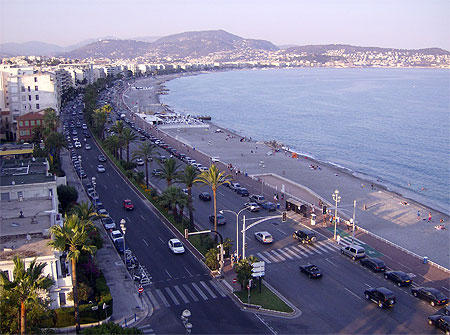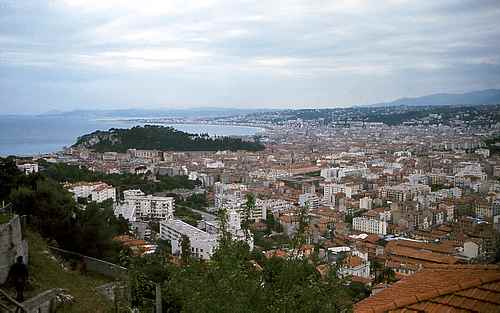Muahahaha....okay, so maybe your idea of scary isn't the same as mine. But seriously, pronouns in French are, well...tricky! Some of them just don't plain make sense in English, and others can be loosely translated, but well...we like to take shortcuts in English, and so we aren't accustomed to hearing the full, "proper" version of a sentence. Shall we have a little (I promise!) French lesson now, so that I can explain my point??
So, let's start off simple. You're in France, and you notice a really nice car. You want to tell the owner that you like it. So, what would you say? Well, of course you can say "j'aime la voiture" (I like the car), but I mean... that sounds a bit cumbersome, don't you think? To make it sound a bit more fluid, you would instead say "je l'aime", or "I like it". In this example, the pronoun "la" replaces the subject of reference in the sentence... "the car" becomes "it". And in French, you place the pronoun in front of the verb as a rule. Easy enough, right?
Okay, let's make things more interesting. Say you are talking to a group of friends about Nice, and how you are going there in September (if you are clever enough, you might notice I just used a pronoun in this sentence...if not, you shall figure it out after these next couple sentences). Now, for whatever reason, you feel the need to explain to your friends en français about your exciting news. How ever would you say it?! After my first example, you might be daring and try to figure it out on your own. You might say "okay, Rob. This is easy. Pronouns go before the verb, so I'll have to say je le vais en septembre."
That's a good try, but unfortunately, it's not correct. You see, in French, what pronoun you use depends on a multitude of factors. Let's examine the "no pronoun" version of the sentence:
Je vais à Nice en septembre.
In this case, there is one thing which forces us to use a different pronoun, and it's the à. This little letter forces us to use a new pronoun, which ironically is ALSO just on letter...y. So, we now know the correct way to say it:
J'y vais en septembre. (I am going there in September)
Ahhh, you see?! When translated into English, the pronoun y loosely means "there". BUT this isn't always true, it's better to think of it as "the pronoun to use when the noun is after an à".
So, one last pronoun I'm going to teach you about. Let's say someone offers you some cake. Once again, it is imperative that you reply to them in French for reasons unknown. You want to say that you don't want any cake. So, how would you do this? Well...without using any pronouns, you might say "Je ne veux pas du gâteau". But you're tired from all of this practice using pronouns, and you just want to say the least amount of words possible but still be understood. So, how would you do it? Well...any time you see "de" "du" "de la" or "des", you are talking about quantities. SOME of something. So because it's a quantity of something you are referring to, you need to reflect this in the "shortened version" of the sentence for it to make grammatical sense. How do we do this? In French, we use the pronoun "en". So, you would change your sentence to be "Je n'en veux pas" , or "I don't want any". Think of en as meaning "some" or "any", but as with the previous example, it doesn't always mean that, and it doesn't always translate into anything in English.
So these last two pronouns we learned are probably the ones which cause the most grief. As I've already said, they don't always have an equivalent in English. Sometimes you use them for one version of a verb, other times you don't...and using them incorrectly can change the entire meaning of the sentence. It gets especially tricky when you are using complex sentences. Placement becomes tricky when there are compacted tenses/more than one verb, if the verb is reflexive, or indeed, if more than one pronoun is being used. It's easy to lose sense of the sentence when so many pronoun "shortcuts" are being used, and the order of the pronouns in a sentence DOES matter. What I think is the hardest part about them though, is the fact that they do indeed come before the verb, whereas if the specific object being referred to was still "in" the sentence, it would come after the verb. Since the French place the pronoun before the verb, you somehow have to "know" the thing you are about to talk about, because you have to reference it at the very beginning of the sentence. Oh, and don't forget all of those rules about which one to use and when to use it, or else your sentence might not be at all what you intend to say!
So, moral of the story is, pronouns are tricky, but necessary if you intend on sounding at all polished when conversing in French. I don't like them, and I know that even French natives themselves mess them up -- but hopefully practice WILL make perfect for me.
I hope you found my little grammar lesson understandable and even -- dare I say it -- interesting?! Feedback, as always, is greatly enjoyed. À bientôt !!
(P.S. the title is making reference to the sound a French donkey (âne français) would make, if you say the y and en out loud. Corny grammar jokes....gotta love 'em !! )





